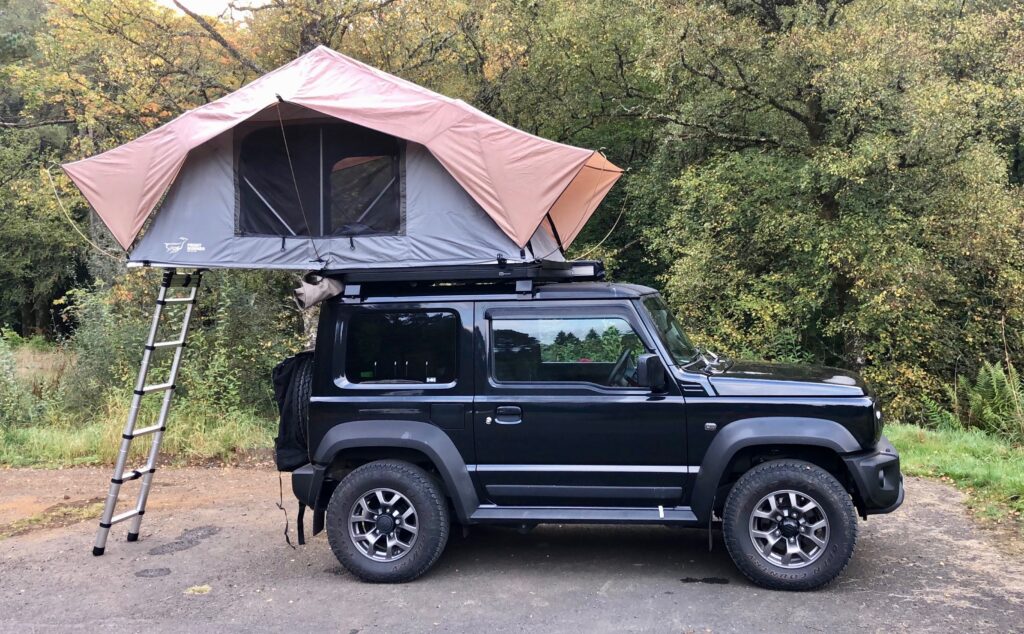Anyone who owns a caravan, camper van or rooftop tent will at some point think about buying an awning. This offers many advantages. An awning/annex is an air lock, mud flap, water barrier, shelter from the wind, and can serve as additional storage space. For long-term campers in particular, the expansion of an awning is recommended, of course only if it is waterproof. Below you will find out what you should pay attention to and how you can easily repair the awning yourself in the event of damage.
Table of Contents
Expand an awning
Anyone who travels a lot with the caravan/camper van or rooftop tent benefits significantly from an awning. For example, you can install a camping kitchen there and do without the standard camping stove, or set up a cozy seating area that offers protection from strong wind or rain. It can also serve as an extension of your living space. You also have a separation between the outside and the caravan, which means that less dirt and cold get into the caravan.
When the temperatures are colder or even in winter, it makes sense to switch to a special winter tent. This has less surface area for wind and rain to attack, and the roof can also be subjected to higher loads. If there is a lot of rain or snow, the roof can absorb it well. In addition, winter tents are equipped with special padding, which prevents drafts and cold. The sealing between the caravan and the tent is also made via the connection pads and is therefore particularly tight and secure. However, it is also possible for you to winterize and weatherproof a normal winter tent yourself, for this you have to seal and insulate the awning. You can find out how this works in detail below.
Insulate the floor of the awning
Sealing an awning is not that difficult, even laypeople can do it themselves. First of all, it is important that you seal the floor, because nobody wants cold and wet feet. Here you have the choice of different solutions.
There are special carpets that are simply placed under the normal or decorative carpet. These insulate the floor and protect against the cold. You can also insulate the floor with a multi-layer floor structure, here you get the best protection against cold and moisture.

Here it is essential to ensure that the floor construction is exactly straight. A layer of spruce beams, thermal insulation made of Styrofoam, squared timber for the edges, a layer of OSB panels and finally a floor covering, for example made of PVC, are suitable as materials.
Insulate the ceiling of the awning
The roof fabric of the awning should also be tight. You can achieve this by covering the ceiling with a headliner. This not only prevents heat loss, but also the formation of condensation.
If you also want to protect yourself against the cooling of your tent, you can hang a carpet, which is actually intended for floor insulation, on the roof poles. This is sometimes good protection, especially in winter. These carpets also absorb moisture.

>> Click Here To Find The Right Tarpaulin <<
A tarp as a roof can also help. Cable ties and tension belts ensure the necessary attachment. A roof protection tarpaulin as a superstructure is also an effective solution for sealing old awnings.
Seal the walls of the awning
The floor and ceiling are insulated, now the walls are missing so that you can seal your awning. If these are well insulated, this makes the temperature exchange much more difficult.
This means that condensation, cold and heat don’t stand a chance. To do this, fill the awning between the profiles with styrofoam, be very precise, it really has to fit in the end. Now cover the whole thing with foil and cover the inside of the tent with profiled wood.
If you don’t want to use Styrofoam, you can also use insulating wool. The weak point in the awning is usually the tent seams. Wetness and cold can easily move in here. There is a special tent seam sealing tape for this.

>> Click Here To See The Product On Amazon.com <<
Seal the awning with impregnation
You can seal the roof and walls of your awning with a waterproofing spray. Before you use the waterproofing spray, you should clean the tent thoroughly and let it dry completely.
Spraying the impregnation spray on dirt and old deposits will not bring the desired benefit. As a rule, the impregnation is carried out on the inside of the tent. The reason for this is that less dirt sticks to the inside of the tent and the agent can stick better.

>> You Can Buy This Product On Amazon.com <<
With the agent, you apply a coating that can make the tent fabric tight. Even if the fabric has leaks, the spray can help. It then penetrates to the surface and seals the spot. The agent then dries out and seals the leak.
If you use your awning in a living room or kitchen, you should clean it very well before impregnating it, as grease deposits from cooking or nicotine deposits are not compatible with the impregnating spray or make it ineffective.
It pays to always have the remedy with you, so you can use it quickly on the go. Leaks and other problems with the tent can always occur. As you can see, sealing and removing old awnings is no problem. But keep in mind that a removed awning is no longer mobile and is therefore most suitable for long-term camping.







